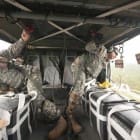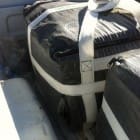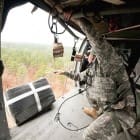The Rapid Equipping Force worked with material developers Product Director Joint Service, Armament Research, Development and Engineering Center (ARDEC) and Natick Soldier Research Development Engineering Center (NSRDEC) engineers on the Enhanced Speed Bag System.
The ESBS is designed to rapidly resupply ground troops via low altitude helo drop. The system consists of a hands free linear brake, rope and padded bag.
Normally, when supplies are kicked from a helo, upwards of 50% of are destroyed upon impact. With ESBS the brake automatically applies friction to the rope orienting the bag with the padded base down. This means you only have to pad the bottom of the bag and in testing, only about 10% of supplies are damaged.
In addition to increased survivability of critical supplies such as ammunition, food, water and medical hear, ESBS standardizes helo resupply equipment and procedures.
Tags: Rapod Equipping Force






THIS is really cool and someone deserves a bonus. Of course, the commendation will go to some staff officer that implemented a new form to track the issuing of paper clips… but this is genius. You called them SpeedBags and not SpeedBalls? I thought it was going to be a boxing trainer item for a minute.
Some guy in Lightfighter’s forum should be happy ????
Just the fact that Big Army is taking the concept seriously is pretty damn cool.
Its like LCLA drop, minus the chute….
Poncho parachutes and padded duffle bag drops were SOP in LRSD at the 101st back in the 90’s and we didn’t lose 50% of the drop. We even did a rucksack drop system off one side of the helo using rappel equipment while the team FAST roped off the other side.
Solution looking for a problem.
This. It is still done and works as advertised, and you don’t destroy 50% of the contents. Now, it is only one bag though. This system is interesting in that it can supply multiple packages at a time.
I do have two big questions though. First, how long does it take to deliver all of the contents? Does the descender/brake allow the load to drop at a decent rate, or is it slow?
Also, what is the standard length of rope that is being used to deploy the gear? Wondering if this is capable of resupplying in triple canopy environment.
To answer you questions two typical Soldiers can empty the aircraft of 6 packages in approx 8 seconds that’s from push them out to aircraft departure.
Yes this will punch through canopy and trees it descends at 40-50 fps which provides plenty of force to keep going down through.
The FLARNG UH-60L unit formerly at Lakeland (KLAL) be used to do this when I was in the unit in 1999. My understanding is that it was a carryover of supporting the FLARNG SF and Recon guys. I personally never did it and can’t remember what they called it. However, it was a unit unique training certification. I suspect that it origionally started over the jungles in Vietnam. My WAG (Wild Assed Guess).
Glad to see someone somewhere listened.
So how does it work if you are in thick canopy? And what is the make payload? As a former rigger I ask this because I cannot tell you how many times we would do a door bundle of fuel and loose most or all of it. But it would be awesome if you could just drive up have the package delivered into the back of you Vic and CM. Na mean?
In the jungle, sometimes the rotorwash blows the tree tops out of the way and you might find a hole big enough to hoist or drop stuff down. Sometimes you don’t and you look for a hole.
As far as the rigging, I’m not sure. The think FL guys used duffel and parachute bags configured w/ rope/rappel lines for the brake. There was a lot of setup and prep time by the crew chiefs. It looks like these ESBS gear “standardizes” and shortens the prep time.
From a pilot perspective, it didn’t seem like a big of a deal. However, I was used to doing 100-150′ hoists from Huey’s that took forever. I never did it though. My 2 cents.
I met the team conducting the testing at JRTC. The rope is Kevlar based and about 1/4″ in diameter. It is a kick and forget system with the lengths pre-determined. The arrrestors slowed the rate of descent but not by much. The bags were heavily padded, but limited in size. They worked great during the exercise.